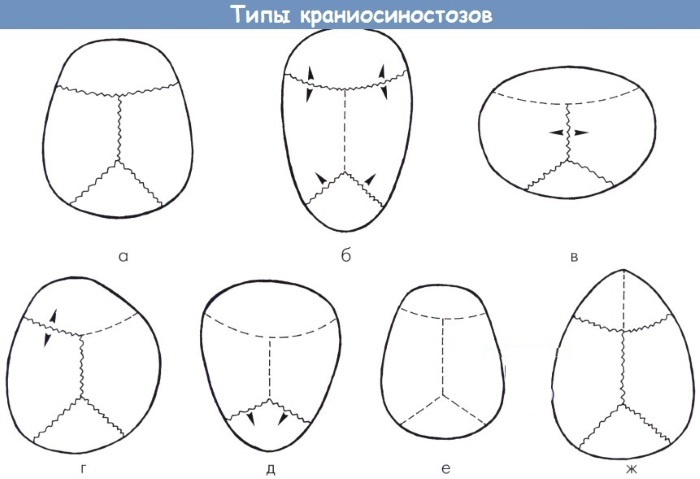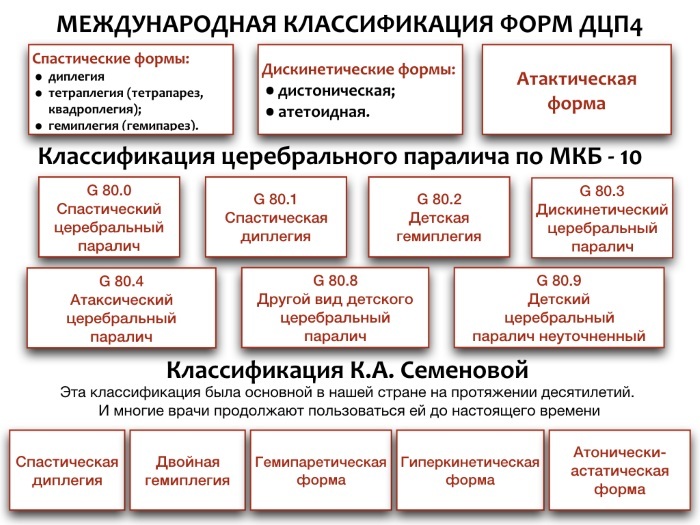Greef's syndrome is a neurological a disease in which a child has bilateral paralysis of the oculomotor muscles against a general background of degenerative processes in the nerve cells.
In infants with this disease, the eyes are constantly directed downward and the iris of the eye is partially behind the lower eyelid. Most often, the disease affects newborns and requires qualified treatment to alleviate the child's condition and prevent severe complications.
Record content:
- 1 Views
- 2 Symptoms
- 3 Reasons for the appearance
- 4 Diagnostics
- 5 When to see a doctor
- 6 Prophylaxis
-
7 Treatment methods
- 7.1 Medications
- 7.2 Traditional methods
- 7.3 Other methods
- 8 Possible complications
- 9 Brain Disease Videos
Views
There are 2 main types of the disease:
- Temporary (transient), in which symptoms appear when the position of the baby's body changes;
- systematic, when symptoms appear periodically, regardless of the position of the body or the movement of the baby.
In the first case, the disease is most often associated with the underdevelopment of the nervous system in the body of the newborn. Within 2-3 months, with proper care and following the doctor's recommendations, the disease goes away on its own without additional treatment.
In case 2, the disease can be caused by reasons requiring urgent treatment, therefore, when symptoms of the disease should immediately contact the pediatrician for additional examination and consultations.
Symptoms
Gref's syndrome in infants has serious manifestations and is accompanied by a number of symptoms that can be used to accurately diagnose the disease.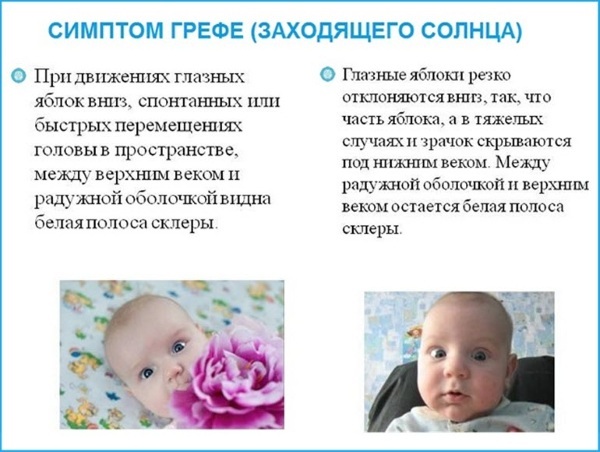
These include:
- unreasonable eye movements in a newborn in a vertical and less often horizontal direction with a high frequency and amplitude. At the time of an attack, a strip of protein can be seen over the iris of the eye. Eye movements occur spontaneously in newborns and are observed over a long period of time;
- blue discoloration of the nasolabial triangle under the nose and limbs in a child due to insufficient oxygen supply to tissues;
- disruption of the cardiovascular system, which is manifested by "marble" skin in a child. Veins and blood vessels are clearly visible on the pale skin of the baby;
- a sharp atypical change in the body temperature of the baby, regardless of the environment. This is due to a violation of the natural thermoregulation system in the body;
- rapid shallow breathing for no additional reason;
- weak and fast heart rate;
- incorrect position of the child's body. In a newborn, there may be an oblique displacement of the limbs or head in relation to the rest of the body;
- the disease is always accompanied by weakness and minor intermittent cramps throughout the body or limbs. Reflexes are almost not observed;
- the baby eats little and often spits up;
- sometimes a newborn additionally develops a squint;
- frequent, unreasonable crying of the child;
- the newborn's head is enlarged and often tilted back when an attack occurs.
If most of the symptoms are present, parents should immediately visit a pediatrician for examination and counseling.
Reasons for the appearance
Gref's syndrome in infants, like any neurological disease, can develop during intrauterine or postnatal development. It arises as a reaction of the organism to the conditions of development.
The main reasons for the development of the disease include:
- premature (earlier than 36 weeks) or late delivery (more than 42 weeks);
- heavy (long) childbirth, birth trauma;
- heredity;
- metabolic disorders;
- toxicosis in the early or late stages of pregnancy;
- neoplasms in the brain;
- neuroinfection (meningitis, encephalitis, arachnoiditis);
- intracranial hypertension of unknown origin;
- spinal cord injury;
- hypoxia (restriction or complete cessation of oxygen supply) of the fetus;
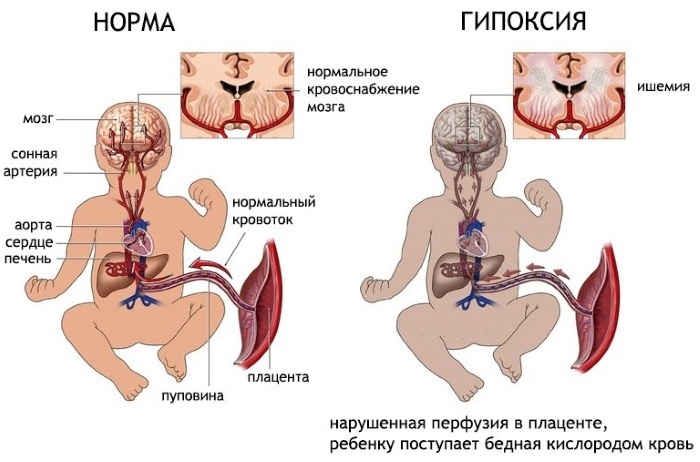
- chronic or infectious diseases of the mother during pregnancy;
- in rare cases, the causes of the disease can be poor ecology.
Diagnostics
Gref's syndrome in infants is diagnosed primarily as a result of examination by a pediatrician and on the basis of complaints from the baby's mother.
However, to confirm the diagnosis, additional examination is required, including:
- a general analysis of blood and urine, which determines the general condition of the child, the presence of inflammatory processes and infection. Parents collect urine from babies and hand them over in a plastic container on their own. Blood for analysis from a newborn is taken from the finger, hand or heel of the child, depending on the condition of the veins. This can only be done by qualified laboratory assistants in the local polyclinic or any medical laboratory. The cost of a blood test is 500 rubles, and an average of 300 rubles for a urine test;
- the pediatrician necessarily prescribes an examination by a neurologist to establish compliance with development, check reflexes and confirm the neurological status of an infant. The neurologist checks the tone in the baby's body, establishes the basic reflexes and the condition of the baby. Research is carried out by a pediatric neurologist in a polyclinic or in a medical center. Its cost is 700 rubles;
- if possible, an examination by an ophthalmologist to check visual acuity is carried out. The research is carried out in the following order:
- Newborns are inserted under the lower and upper eyelids with special metal fasteners to fix the eyes in the open state.
- The ophthalmologist, using a special mirror with a small hole and a flashlight, directs a beam of light into the child's pupil and examines the eyes and the visible part of the fundus through a magnifying glass.
The procedure takes no more than 5-7 minutes. As a result of the study, the ophthalmologist can establish the presence of a serious decrease in visual acuity and changes in the state of the vessels of the fundus.
The study is carried out by a qualified specialist in a specially equipped office in a polyclinic or medical center, which has a pediatric ophthalmologist on staff. The cost of the procedure will be from 800 rubles;
- if a neoplasm in the brain is suspected, the child is prescribed ultrasound of the brain. During the procedure, the baby's head is viewed externally with an ultrasound device. The procedure is carried out in the area of the crown and lateral frontal parts in a special office of the clinic or a specialized medical center. The procedure allows you to quickly and painlessly identify the presence of a neoplasm, its structure and location. The cost of the procedure is 800-900 rubles;
- A more modern, similar method is neurosonography, in which the study is carried out using an ultrasonic wave. The ultrasonic wave passing through the head tissue is reflected differently from each layer and forms an accurate picture on the monitor. This procedure is considered absolutely safe for the child and can be repeated several times.
 Accurate information about the internal state of the brain allows you to assess the ventricles of the brain, the state of the medulla and give an accurate description of neoplasms, if any. The procedure is carried out in large clinics and hospitals, as well as specialized medical centers. The cost of such a procedure is from 1200 rubles;
Accurate information about the internal state of the brain allows you to assess the ventricles of the brain, the state of the medulla and give an accurate description of neoplasms, if any. The procedure is carried out in large clinics and hospitals, as well as specialized medical centers. The cost of such a procedure is from 1200 rubles; - In rare cases, to exclude anomalies in the development of the skull, it is prescribed head x-ray. It is a method in which it is possible to assess the state of the bones of the skull and the state of the brain, the presence of developmental abnormalities. As a result of such a study, it is possible to accurately diagnose some types of diseases and prescribe treatment. The procedure is carried out in the X-ray office of a polyclinic or medical center on special equipment, where within 10-15 minutes you can get the result of the study with a decryption. The cost of the study is 500-800 rubles;
- Electroencephalography allows you to assess the state of the brain. Sensors fixed on the baby's head allow you to quickly and accurately record the foci of pathology, disturbances in the functioning of the brain, the nature and degree of damage. The procedure effectively allows you to establish Gref's syndrome and prescribe an accurate treatment. Research is carried out in a special office of a polyclinic or a specialized center, which has the appropriate equipment, only by qualified specialists. The price of the procedure is 700-900 rubles;
-
magnetic resonance imaging of the brain or more modern computer topography makes it possible to determine the state of the cerebral vessels from large to small in layers. Establish blood supply disturbances, the presence of hemorrhages and their causes. The study gives a clearer picture of the state of the brain, allows you to accurately determine the location of the pathology, its boundaries and influence the method of treatment. The procedure is carried out in large hospitals or medical organizations using high-tech equipment. The cost of the research is on average 2500-3000 rubles.
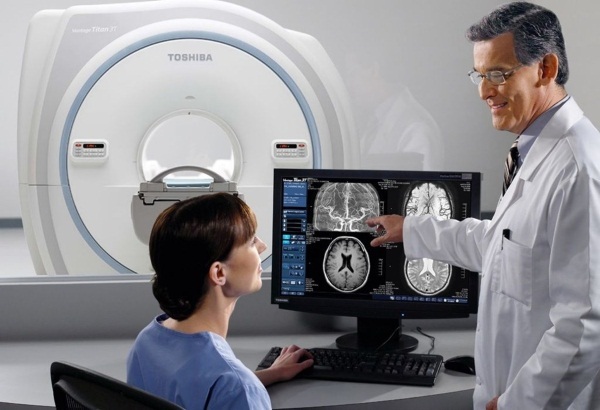
Since the causes of the development of Gref's syndrome in infants can be varied, in any case, it is possible to make a diagnosis only after passing a full examination.
Each of the diagnostic methods has its own advantages and disadvantages, so the pediatrician selects for a newborn set of studies that will allow to establish Gref's syndrome in a child and identify the cause in a specific situations.
Establishing the features of the development of the disease through different detection methods will allow the doctor to identify and eliminate the cause of the disease, choose the right treatment for the newborn, taking into account its characteristics and effectiveness impact. After treatment, the infant is assigned a second examination.
When to see a doctor
In any case, upon detection of the first symptoms of the disease, which is often accompanied by weakness and convulsions in an infant, you should immediately contact a pediatrician for examination and consultation.
The examination assigned in this case will allow to establish a possible cause. With an underdevelopment of the nervous system, the disease does not require treatment and quickly goes away on its own within a few months after birth.
However, if symptoms persist and progress, the newborn is required to a medical course of treatment that will relieve the symptoms of the disease and speed up recovery baby.
Prophylaxis
Gref's syndrome in infants is a rare and complex type of disease.
However, the disease can be avoided with the following prevention methods, which should be carried out before the baby is born:
- even during pregnancy, the mother needs to undergo all examinations and, if infectious diseases are detected, carry out treatment in accordance with the doctor's recommendations;
- pregnant women are advised to walk, monitor their diet and avoid stress;
- during the period of bearing a child, alcohol and tobacco should be completely excluded;

- expectant mothers are advised to follow the drinking regimen and monitor blood pressure. With a frequent increase in pressure, the doctor prescribes inpatient observation and drug treatment for the expectant mother;
- pregnant women are advised to strengthen their immunity when carrying a child and take care of colds and flu;
- during pregnancy, you should refuse to take non-vital drugs, and the use of other drugs should be agreed with the gynecologist.
Timely monitoring of the health of a pregnant woman and modern methods of treatment and diagnosis allow exclude all unfavorable factors in the development of pregnancy or reduce to a minimum possible complications in the form of manifestations of the syndrome Grefe.
Treatment methods
In the case of a transient type of disease, specialized treatment of an infant is not required. In this case, parents are advised to monitor the correct observance of the regimen during the day, feed the child on demand and walk for a sufficient amount of time.
The child is prescribed a light massage, daily air baths and bathing in a warm bath every day. Silence and a favorable environment in the family contribute to improving the health of a child with Gref's syndrome.

If the recommendations are followed, many newborns quickly recover completely and then visit a neurologist for up to a year to monitor their condition.
If the disease is not associated with underdevelopment of the nervous system, the infant requires compulsory drug treatment. Treatment of Grefe's syndrome is carried out most often on an outpatient basis under the supervision of a specialist and includes a set of drugs aimed at restoring the nervous, cardiovascular systems of an infant.
| Direction of treatment for Gref's syndrome | A course of treatment |
| Anxiolytics and anticonvulsants | up to 14 days |
| Diuretic drugs | up to 7 days |
| Improving metabolic processes in the brain, increasing blood circulation | up to 10 days |
| Antiviral and anti-infectious drugs | 5-7 days |
| Vitamins course | up to 30 days |
Medications
The treatment of Gref's syndrome is carried out in a comprehensive manner and consists of several directions of exposure to the newborn's body:
- The newborn is prescribed diuretics that help remove excess fluid from the body, including cerebrospinal fluid, which negatively affects the brain.

Furosemide is the most popular diuretic for weight loss
Furasemide is effectively used for these purposes, which is suitable for taking from birth.
The medicine is prescribed at the rate of 1 mg / kg per day and is divided into 2-3 doses during the day. The course of treatment is 5-7 days, which can be repeated. The drug has excellent diuretic properties and does not affect the development of the baby, on the contrary, contributing to the normal functioning of individual organs and systems. Its cost is 80 rubles.
Diacarb is activated at the level of cells and acts in case of cerebrospinal fluid disorders, helping to reduce hemorrhages.
The drug reduces the production of cerebrospinal fluid at the level of the choroid plexus of the brain. Together with the accumulation of the drug in the blood, the diuretic properties of the drug are activated. The dose is calculated from taking into account 8 mg / kg of body and divided into 2-3 doses during the day. The course of admission is up to 7 days. The maximum effect of the drug is achieved on the 3rd day after the start of administration. The cost of the drug is 250 rubles.
- In parallel, the baby is prescribed a course of sedatives that reduce anxiety and have hypnotic properties.
Tazepam has pronounced anticonvulsant, hypnotic and sedative properties.
The drug is approved for admission from birth and effectively reduces the child's hyperexcitability. The medication is taken at 5-8 mg / kg and is taken in equal doses 3 times a day for 10 days. The price for a package of the drug is 150 rubles.
Diazepam has a calming effect on the child's body and reduces seizures.
The medicine is quickly absorbed and excreted from the body by the kidneys, positively affecting the state of the brain. The daily dose of the drug for an infant is calculated by weight and averages 125 μg.
It is taken during the day in 2-3 equal doses in the form of crushed tablets or intramuscularly. Reception time is set individually and is 5-10 days. The cost of the drug is 450 rubles.
- To activate the neurometabolic processes in the brain, the infant is prescribed a course of nootropics.
Piracetam within a few days improves all metabolic processes in the tissues of the brain and improves blood circulation.
The drug has a protective effect against any brain damage, including those associated with hypoxia, intoxication. The medicine is taken at 20-30 mg / kg per day in equal doses throughout the day for 7-10 days. Packing price is 70 rubles.

Cinnarizine blocks the negative effects on the brain of harmful substances, improves the general condition of the brain.
It effectively reduces the excitability of the vestibular apparatus and increases the resistance of brain tissue to hypoxia. The exact dosage is set only individually, taking into account the condition of the child and averages 5 mg per day. The drug is taken within 7 days. The price of the medicine is 45 rubles.
- To normalize blood circulation in the brain, the patient is prescribed drugs that increase blood circulation by toning individual tissues.
Curantil actively improves microcirculation, reducing the number of leukocytes in the blood and increasing the body's resistance to infections.
The drug is considered one of the best and most harmless drugs that have a positive effect on the nervous and cardiovascular systems of the body. It is taken at 10-20 mg per day, dividing the drug into several doses. The course of treatment can be up to 30 days. The cost of the medicine is 700 rubles.
Actovegin increases the microcirculation of capillary blood flow, reducing the overall tone of the nervous system.
The drug effectively promotes the renewal of damaged brain cells. A single dose of the drug for an infant is set individually and can be up to 50 mg, which is administered intravenously. The general course of treatment is no more than 10 days. The cost of 1 package of the drug is 550 rubles.
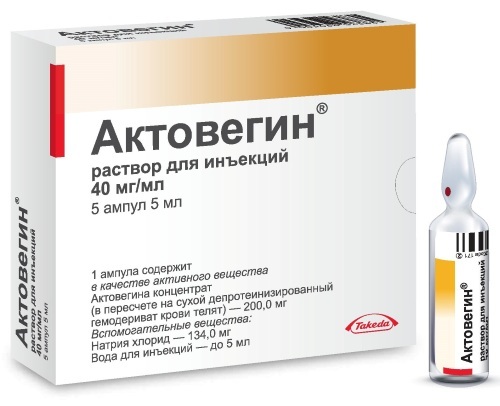
- Additionally, in the presence of infections, the baby is prescribed antibiotics or anti-infectious drugs of the corresponding specificity.
- To maintain immunity, the baby must be prescribed a course of multivitamins, which activates the general development of the body.
The solution Polivit baby contains the main groups of vitamins necessary for the proper development of the child.
A liquid preparation of 2-2.5 ml is poured into the mouth of a newborn or mixed with milk when feeding. The drug is quickly absorbed and does not have a pronounced taste. The course of taking the drug is 2-3 weeks. The cost is 150 rubles.
Multitabs baby is also a solution and contains vitamins A, D and C.
1 ml of the drug or 15 drops. give the baby with a measuring spoon or mix with milk at the time of feeding. The vitamin composition quickly increases the required rate of nutrients in the body and helps to activate the immune system. The course of admission is 30 days. The cost of the drug is 380 rubles.
In severe cases, the treatment of an infant is carried out on a stationary basis by introducing special drugs intravenously.
Traditional methods
In infants, folk methods of treating Grefe's syndrome are used only as an adjunct to the prescribed medication course of treatment only after prior consultation with a pediatrician. It is not recommended to take decoctions and infusions of medicinal herbs for a newborn baby, however, there are several alternative methods that will contribute to the quick recovery of the baby:
For relaxation, the child is recommended to do baths with chamomile and a series of:
- 0.5 tbsp. l. turns and chamomile brew 1 stack. boiling water and insist for 30-40 minutes.
- The solution is filtered and poured into the baby's bath. The child is bathed in a warm solution for 15-20 minutes, and then rinsed with clean water and wiped dry.
Instead of a decoction of herbs, you can add a few drops of lavender infusion to the bath. Approximately 3-5 drops. 10 liters.
A decoction of nettle and string will help soothe and reduce cramps:
- For its preparation, 1 tsp. l. dry nettle leaves and flowers and leaves of a string are brewed with 250 ml of hot water.
- The mixture is placed in a steam bath for 10 minutes and infused for 20 minutes.
- Then the broth must be filtered and added to the bath.

To reduce muscle tone, a massage with boiled olive oil is prescribed for an infant:
- 100 ml of high quality fresh olive oil is poured into a saucepan.
- The oil is heated to a boil and cooled to room temperature.
- The child's legs and arms are massaged with chilled olive oil, gently rubbing and relaxing the muscles.
Traditional medicine methods can be used in infants only if there is no allergy to the components of the product. In the event of a rash, redness, the use of folk remedies must be abandoned.
Other methods
As a supplement to the medication course of treatment, the pediatrician or neurologist may prescribe concomitant physiotherapy procedures that will further normalize the baby's condition.
These include:
- Massage of the cervical-collar zone of the spine, which is carried out only by a qualified pediatric masseur in the clinic. The masseur kneads the neck and its base of the head with light circular movements, tapping for 10-15 minutes. The course of the procedure is 10 days. Thanks to the massage, the number of seizures in the child is reduced, the brain is supplied with more oxygen and cleansed. The baby becomes calmer.
- Magnetic therapy is effectively used to restore blood supply. Magnets are applied to the neonate's collar zone for 2 minutes. The course is repeated within 10-14 days. Magnetotherapy promotes the restoration of microcirculation in the brain, improves the condition of the brain and relaxes the muscles of the back and neck.
In addition, strict adherence to the daily regimen, daily relaxing evening baths with herbs and without, walks in the fresh air contribute to the rapid recovery of the baby's health.
Possible complications
Gref's syndrome is a serious illness and requires immediate treatment under the supervision of a specialist, and in severe cases in a hospital setting.
In the absence of timely medical care, a newborn may experience the following consequences:
- in an infant, sharpness rapidly decreases and vision is affected. Bacteria can enter permanently open eyes and cause corneal ulcers;
- the disease is often accompanied by caries. In children with Gref's syndrome, the mouth is constantly open during the day, into which bacteria penetrate. Increased dryness and bacteria destroy thin children's enamel and provoke caries;
- due to seizures in a child, joints can be affected and suffered;
- shallow breathing is manifested in underdevelopment and the appearance of chronic lung diseases;
- weakness and frequent regurgitation of food after feeding can lead to dehydration and weight loss. If qualified assistance is not provided, the newborn may lose consciousness and fall into a coma.
Gref's syndrome is a complex and rare type of disease that can be well treated with complex effects in infants.
In addition to medication, the child must necessarily receive physiotherapy, as well as increased care in compliance with the daily regimen. With the strict implementation of all the recommendations, the baby's health within 2-3 months returns to normal and is restored for a long time.
Brain Disease Videos
Hydrocephalus - dropsy of the brain:


